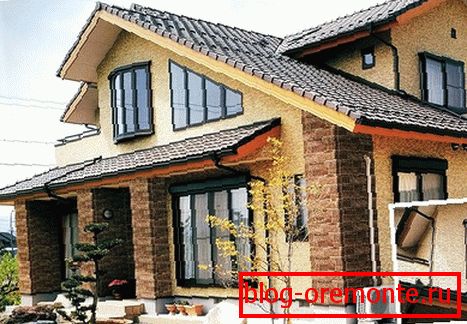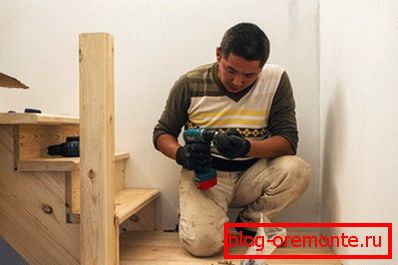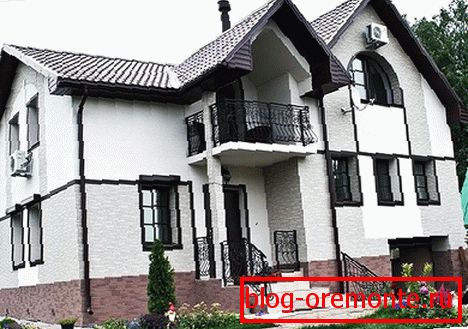Decorating houses with japanese panels
Exterior cladding of the house with facade panels gives it a neat modern look and serves as protection from environmental influences. Japanese panels are made on high-tech equipment and have excellent quality standards. Of them are mounted ventilated facades for private houses and public buildings. The cladding material is dense fiber cement, the outer part of which can be of various textures and colors. Finishing of houses with Japanese panels is designed for difficult climatic conditions and can be used in various regions.
Material Features

The raw material for the production of cladding is fiber cement - a composite material based on cement with the addition of fibers of viscose and cellulose, as well as inorganic additives. The absence of toxic components in the composition of the material makes it possible to use it as an interior finish:
- Mineral fillers give panels strength and flexibility.
- The treatment of plates with high temperature and pressure in industrial autoclaves makes them particularly strong and durable.
- The outer layer of Japanese panels is covered with a special hydrophilic composition based on silicon, which promotes self-cleaning of the material.
- Despite the complex texture, the facade is easily cleaned when it rains or by pouring out a hose.
Note! Several Japanese companies are engaged in the manufacture of panels, their properties differ depending on the type of additives in the cement base. All plates are united by a standard size: length - 3 m 30 mm, width - 455 mm, thickness varies from 14 to 35 mm.
The durability of the color of the panels is provided by the gradual dyeing with acrylic paint. The photoceramic coating is the most stable, the thin mineral layer prevents the destructive action of moisture and ultraviolet. Outside, the cooker is coated with a composition with light catalysts capable of destroying bacteria. Japanese panels for exterior finish with such a coating are of high cost, due to which they have a long service life. Common invoice options:
- Granite.
- Sawed stone.
- Brickwork.
- Decorative plaster.
- Tree.
Material advantages

- The low weight of fiber cement does not make the facade heavier.
- High moisture resistance of the material created by a special protective layer, and the absence of fibers that adsorb moisture.
- Over the years of operation, the Japanese panels do not lose color, do not collapse and remain in their original form.
- Finishing is designed for 300 cycles of freezing and thawing, it is not afraid of a sudden change in temperature.
- Refractory material.
- The outer layer of ceramic coating protects the slab from mechanical damage.
- Finishing reduces noise and is an additional thermal insulation.
- Japanese building materials are designed with seismic activity into account, they have high resistance to dynamic loads.
Note! The ventilated facade system, created using panels, provides free air circulation, helps to remove moisture, and provides space for insulation.
The only downside to finishing is its high cost. The price of fiber cement boards depends on their thickness, panels of 35 mm are 4–5 times more expensive than the thickness of 14 mm. If the building is located in a warm region, then it is possible to install a lining of average thickness, which is cheaper.
Popular manufacturers

Among the companies producing fiber cement panels, it is worth to highlight KMEW and Nichiha.
In the composition of the plates from Nichiha wood fibers, as well as inorganic components - this made it possible to reduce the weight of the lining and increase its strength. The panels provide a high degree of sound insulation, they are resistant to fire. The unique color rendition is the business card of the company; the panels have undergone multilayer coloring with a base, toning and a protective coating.
KMEW panels are resistant to moisture, therefore, recommended for finishing the basement. The material is not subject to burning and melting, it is environmentally safe, not afraid of temperature changes. These panels are characterized by high thermal insulation properties. In their structure there are cavities created by elastic microgranules. In terms of the number of variants of the exterior texture and color, the brand is inferior to Nichiha, but the presented models are enough to make your choice.
Preparing to install

If the house has several floors, the work begins with the installation of scaffolding, from which it is convenient and safe to fix the frame and panels. The walls of the building are cleaned of all protruding parts, lighting and ebbs. It is necessary to draw up a drawing so that the docking seams are symmetrically arranged. According to the sheer level, the surface is marked under the mounting brackets.
Required tools:
- punch or drill;
- level;
- screwdriver;
- saw;
- structur;
- hammer;
- roulette.
Installation

To install a ventilated facade with Japanese fiber-cement panels, it is enough to have minimal construction skills.
Note! Versatile dimensions, detailed installation scheme and video tutorials allow you to understand the technology and do the work yourself.
Japanese panels are fixed with clips that create a hidden mount, and screws or nails. The latter method is used for thin plates of 14 mm. The nail cap is neatly painted to match the slab.
- В отмеченных местах устанавливаются кронштейны, они позволяют регулировать металлический профиль каркаса по уровню. Installation японских фасадов может осуществляться и на деревянную обрешетку, но срок ее службы ограничен. Металлический профиль крепится с шагом 600 мм.
- Between the guides of the frame fit insulation, on top it is closed with a waterproofing film. After that, proceed to the installation of fiber cement panels.
- Initially, a starting guide is installed, which is fixed by a screw on each frame pillar, both inside and outside corners. At the junction of the panel and the corner is fixed dividing strip.
- It is necessary to leave 10–15 mm between the lower edge of the panel and the starting plate. This gap is necessary for the entry of air for the design of the ventilated facade.
- The panels are cut with a saw into plates of the required size and the clamps are fixed from the inside. The cutting is done from the inside. For mounting, three types of fasteners are used - general, for external corners and special for left or right fastening.
- The first row is inserted into the starting plate and fixed with a special fastener. The screw must be twisted into the center hole.
- At a distance of 1 m between the panels a dividing bar is installed.
- Installation второго ряда начинается после окончания первого и проводится по такому же принципу. Вдоль оконных и дверных проемов необходимо оставить зазор в 10 мм, а после установки заполнить его герметиком.
- Installation японских панелей завершается установкой финишной планки, подобранной с учетом толщины панели. Конечный этап – закрепление откосов и водостоков.

Japanese panels are a practical and durable finish for low-rise buildings, with which you can create a unique architectural look.
Video
This video describes the advantages of Japanese panels:
And this video shows how to mount Japanese panels: